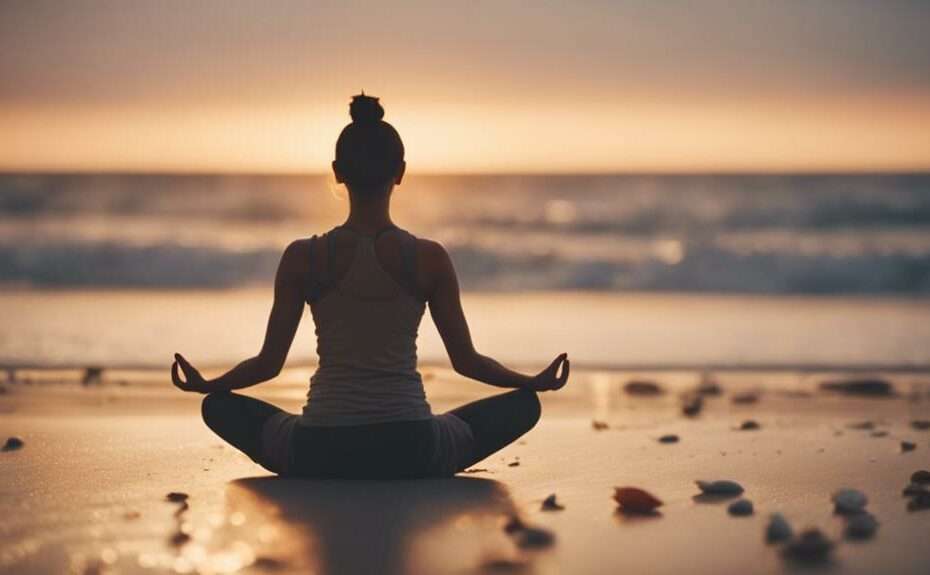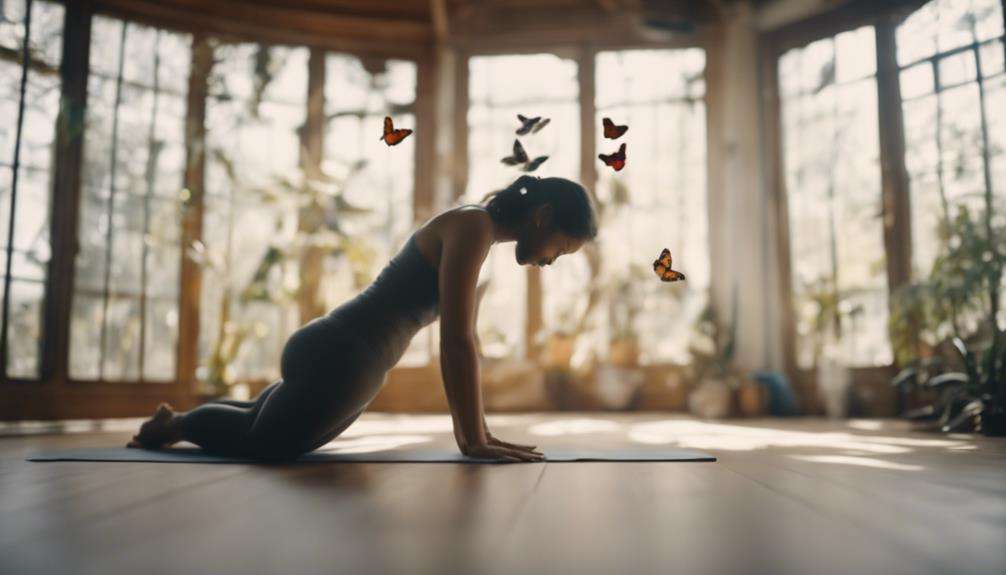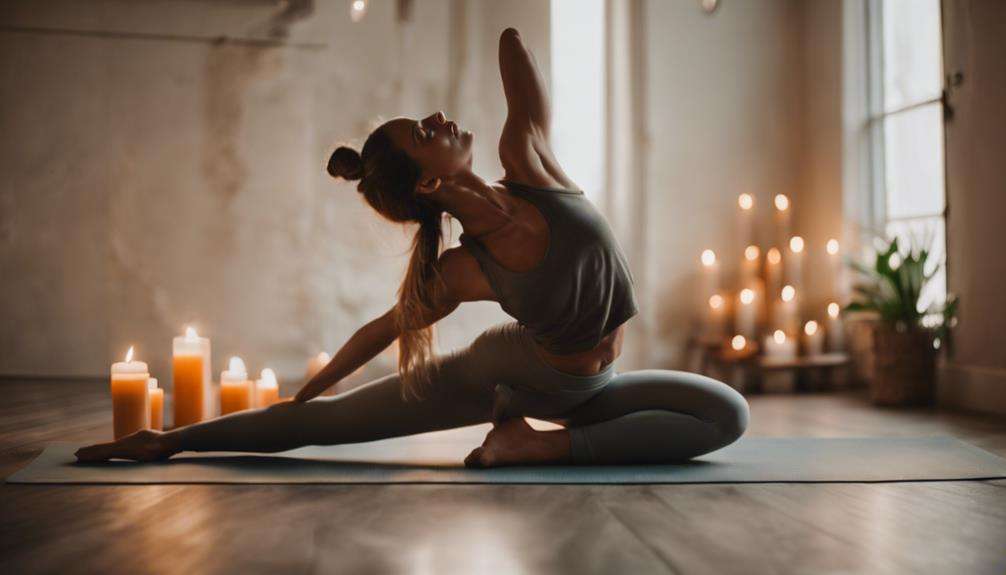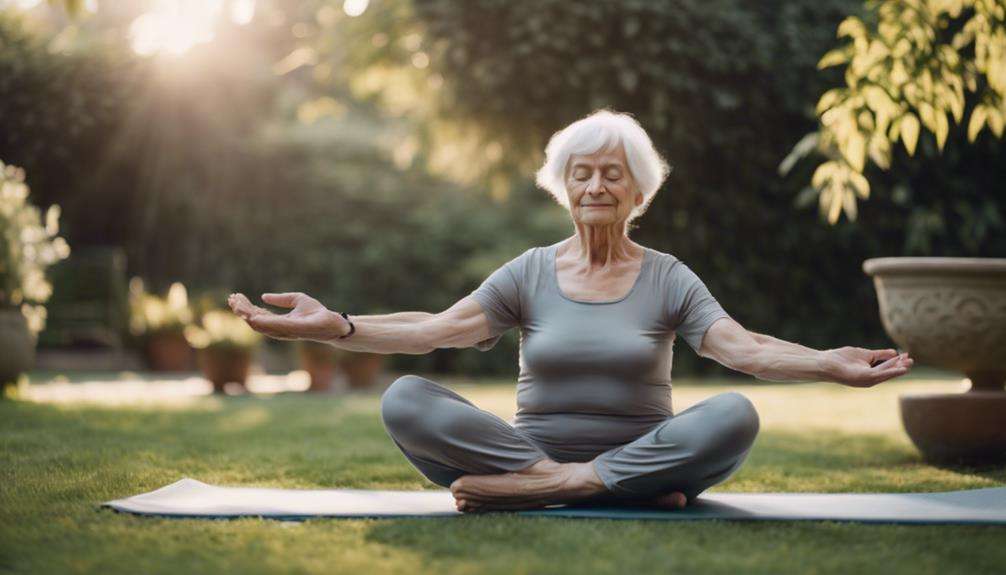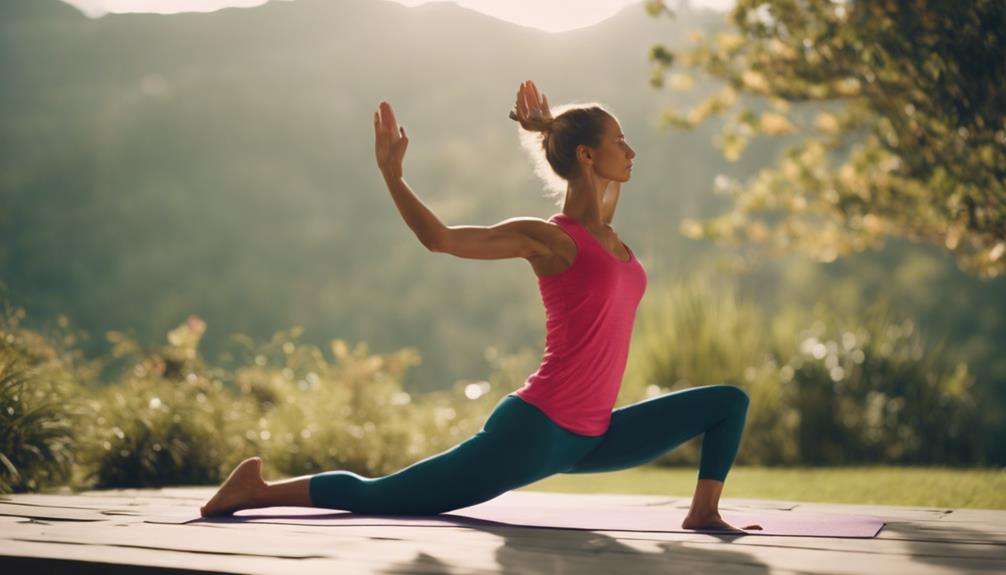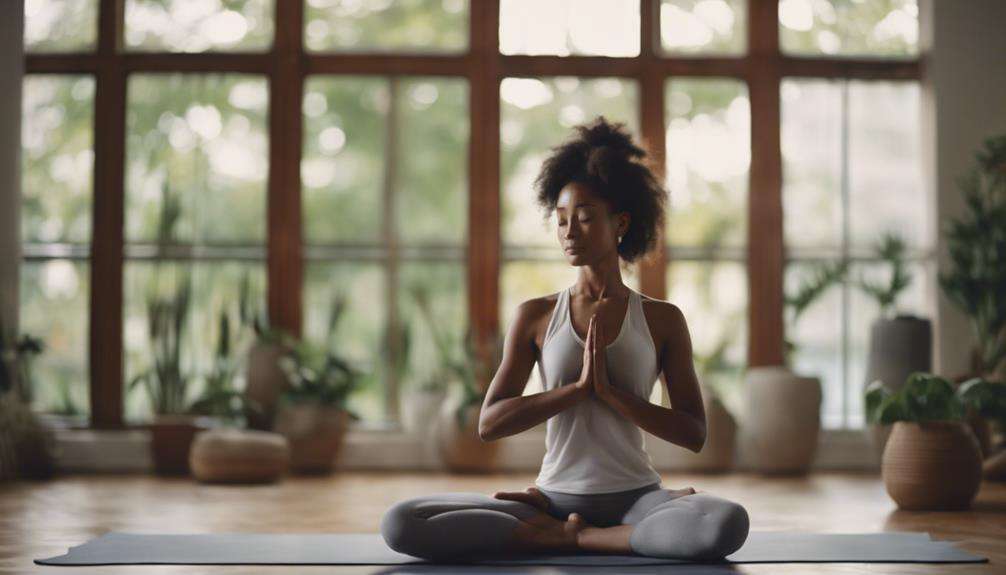As you consider the daily demands and stresses that weigh upon you, imagine a simple yet profound method that could offer relaxation and flexibility, transforming your experience.
Through mindful practice, you can discover a path to a more peaceful and agile existence. By exploring the connection between your mind and body, you'll unlock the potential for deeper relaxation and enhanced flexibility.
This journey can lead you to a state of being where calmness and suppleness intertwine, inviting you to explore further the benefits of this transformative practice.
Key Takeaways
- Cultivate mindfulness and meditation for relaxation and flexibility.
- Enhance body awareness and mind-body connection through mindful movements.
- Utilize deep breathing and progressive muscle relaxation techniques for increased flexibility.
- Reduce muscle tension and stress while improving overall flexibility with mindful stretching.
Benefits of Yoga for Flexibility
Enhance your body's flexibility and overall well-being through the practice of yoga. Yoga isn't just about physical postures; it's a practice that cultivates mindfulness and meditation. When you pay attention to your body during yoga, you develop a deeper connection between your mind and body. This heightened focus helps you notice areas of tension or tightness, especially in your back. Through consistent practice, you'll find that your body becomes more supple, allowing for increased range of motion and joint mobility.
The mindful practice of yoga targets different parts of the body, such as the spine, hips, and shoulders, through various postures. By bringing your awareness to these areas, you can release built-up tension and improve flexibility. This increased flexibility not only benefits your physical health by reducing the risk of injuries but also enhances your posture and balance. Yoga's focus on flexibility can lead to a more agile and resilient body, promoting overall well-being.
Relaxation Techniques in Yoga Practice
Incorporating relaxation techniques into your yoga practice enhances stress reduction and promotes overall flexibility. Deep breathing and progressive muscle relaxation are key components of yoga that help calm the mind and release tension in the body.
Mindful movement in yoga, where breath is coordinated with each posture, improves body awareness and enhances the relaxation response. Poses like Child's Pose, Corpse Pose, and Cat/Cow Pose are especially effective in promoting relaxation, reducing anxiety, and increasing flexibility.
Mindfulness Practices for Flexibility
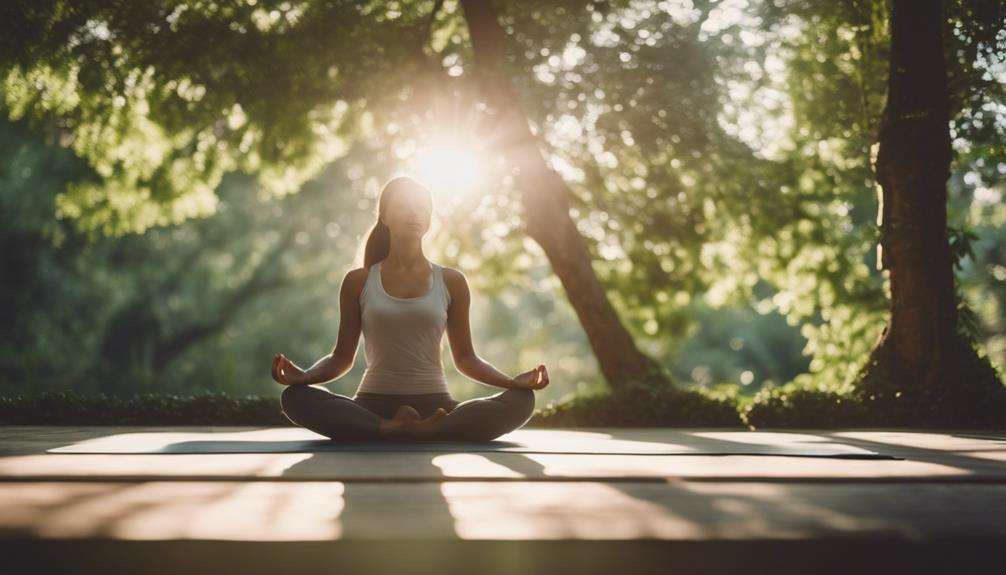
To enhance your flexibility and promote relaxation, practicing mindfulness techniques such as yoga and stretching can be highly beneficial. By combining mindfulness practices with flexibility exercises, you can improve your range of motion, reduce muscle tension, and enhance your overall well-being.
Here are some key mindfulness practices that can help you achieve greater flexibility:
- Mindful movements: Engaging in mindful movements during yoga or stretching sessions can help you focus on body awareness and breath, leading to improved flexibility and stress relief.
- Body scan meditation: Incorporating body scan meditation into your routine can help release tight muscles, improve posture, and prevent injuries by bringing attention to different parts of your body.
- Mindfulness meditation practice: Implementing mindfulness meditation as part of your flexibility training can enhance body awareness, increase mobility, and induce a sense of calmness, allowing for a deeper relaxation experience.
Incorporating Meditation for Flexibility
By centering your attention on meditation practices, you can cultivate a deeper sense of flexibility and relaxation within your body and mind. Mindful meditation plays a crucial role in enhancing flexibility by reducing muscle tension and promoting relaxation. Through mindful meditation, you can increase body awareness, allowing you to identify and address areas of stiffness or discomfort more effectively. By focusing on your breath and body sensations during meditation, you can release physical and mental tensions that hinder flexibility.
Regular meditation not only improves your mindset but also makes you more open and receptive to stretching routines. When you combine meditation with stretching exercises, you establish a stronger mind-body connection that boosts overall flexibility and relaxation. This holistic approach to flexibility training can lead to a more profound sense of well-being and physical ease. Embracing meditation as a core component of your flexibility routine can bring about lasting benefits for your body and mind.
Breathing Techniques for Flexibility
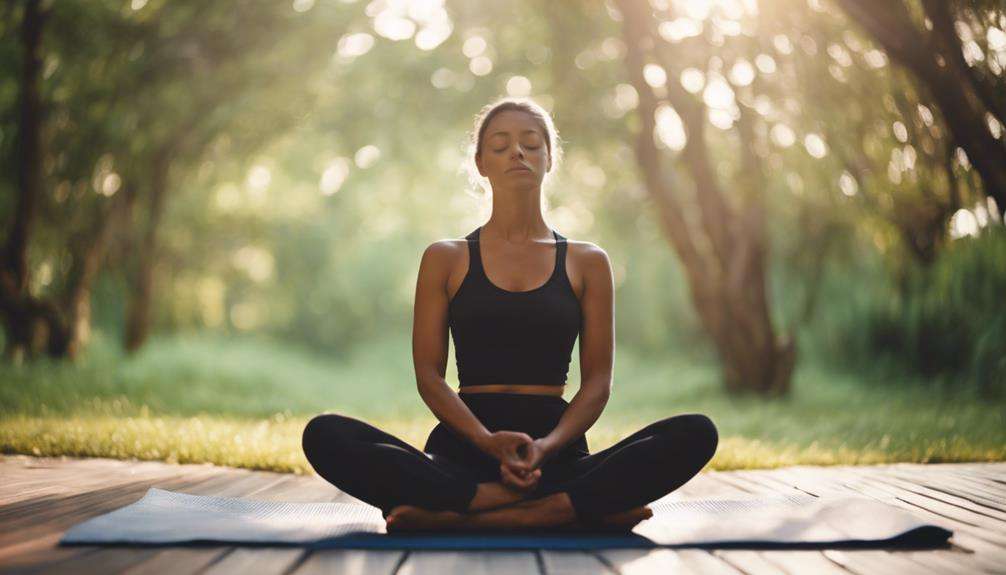
Enhancing your flexibility can be achieved through the practice of specific breathing techniques that promote relaxation and reduce muscle tension. Deep breathing plays a crucial role in increasing oxygen flow to your muscles, which aids in improving flexibility and expanding your range of motion. By incorporating controlled breathing while stretching, you not only help prevent injuries but also enhance your overall flexibility.
Benefits of Breathing Techniques for Flexibility:
- Deep breathing enhances relaxation and reduces muscle tension.
- Increased oxygen flow to muscles aids in flexibility and range of motion.
- Controlled breathing during stretching helps prevent injuries and improves flexibility.
Mindful practice of deep breathing techniques during stretching routines deepens your stretches over time, allowing for greater flexibility gains. By being attentive to your breath, you can connect with your body on a deeper level, fostering both flexibility and relaxation.
Yoga Poses for Relaxation
Achieve a state of deep relaxation and tranquility by practicing restorative yoga poses designed to release tension and calm the mind. Yoga poses like Child's Pose, Corpse Pose, and Legs Up the Wall offer a mindful practice for relaxation.
Child's Pose stretches the back, shoulders, and hips, promoting a sense of calm and soothing the nervous system. Corpse Pose allows complete relaxation of the body and mind, aiding in stress relief and improving overall well-being. Legs Up the Wall pose helps reduce anxiety, insomnia, and fatigue by promoting blood circulation and calming the mind.
These poses encourage deep breathing, activating the body's relaxation response and reducing stress levels. Incorporating these calming yoga poses into your routine can help in releasing tension, promoting relaxation, and enhancing your overall well-being. Embrace these poses as a way to soothe your nervous system and achieve a sense of deep relaxation.
Mindful Stretching for Flexibility
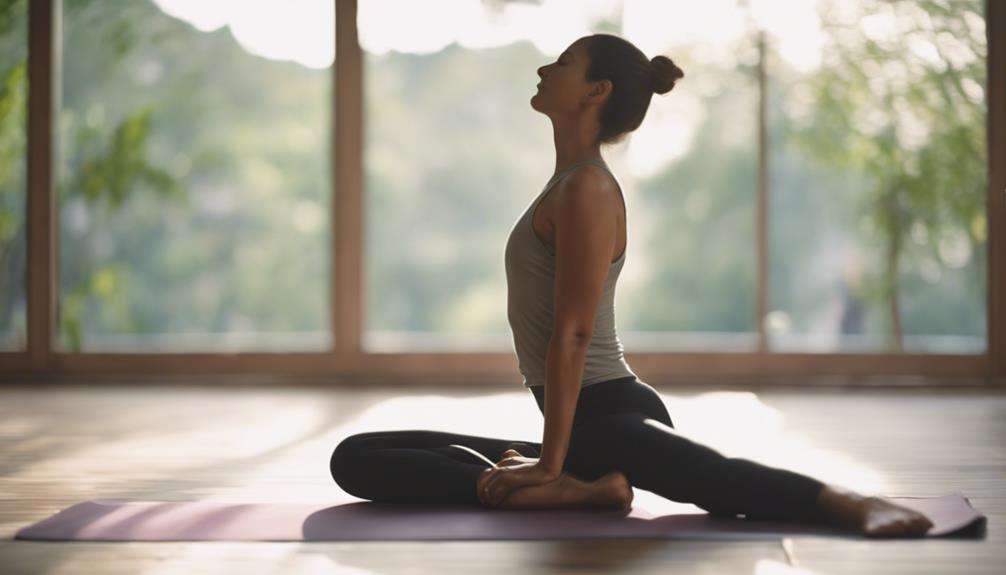
As you start exploring the points of breathing for flexibility and body awareness in stretching, remember to pay attention to your inhales and exhales as you move through each stretch. By honing in on your breath and the sensations in your body, you can deepen your stretches and improve your flexibility gradually.
Embrace this mindful approach to stretching, allowing yourself to connect with your body on a deeper level for enhanced flexibility and relaxation.
Breathing for Flexibility
To enhance your flexibility effectively, begin by incorporating deep, intentional breathing techniques into your mindful stretching routine. Controlled breathing plays a crucial role in preparing your body for flexibility gains. Here's how mindful breathing can help you improve your flexibility:
- Relax muscles: Deep breaths relax tense muscles, making them more receptive to stretching.
- Enhance mind-body connection: Focusing on your breath enhances the connection between your mind and body during stretches.
- Promote relaxation: Mindful breathing reduces stress and tension, promoting a state of relaxation that supports your stretching efforts.
Body Awareness in Stretching
Enhancing your flexibility through mindful stretching involves tuning into your body's sensations and movements with focused awareness. By practicing mindful stretching, you can deepen your body awareness, improve flexibility, and promote relaxation through mindfulness.
Paying attention to your body during stretching exercises helps release muscle tension, correct posture, and enhance overall alignment. This heightened body awareness not only reduces the risk of injuries but also strengthens the mind-body connection.
Whether you choose yoga, Pilates, or specific stretching routines, approaching each movement with mindfulness and intention can significantly impact your flexibility and overall well-being. Embrace the journey of mindful stretching to unlock the benefits of a more flexible, relaxed, and aligned body.
Flexibility Through Mindful Movement
Mindful movement practices, such as yoga and stretching, can significantly enhance your physical flexibility and overall well-being. When you engage in mindful movement, you bring full attention to the present moment, incorporating breath awareness into intentional movements. This focused approach not only promotes flexibility but also aids in reducing stress and increasing energy levels. As you delve into practices like yoga, stretching, or walking meditation, you'll notice improvements in balance, posture, and body awareness. These techniques work synergistically to enhance your physical and mental well-being, offering a holistic approach to maintaining flexibility. By incorporating mindful movement into your daily routine, you pave the way for greater flexibility over time, nurturing a sense of relaxation and mindfulness in your everyday life.
- Enhances physical flexibility
- Reduces stress and increases energy levels
- Improves balance, posture, and body awareness
Enhancing Flexibility With Meditation
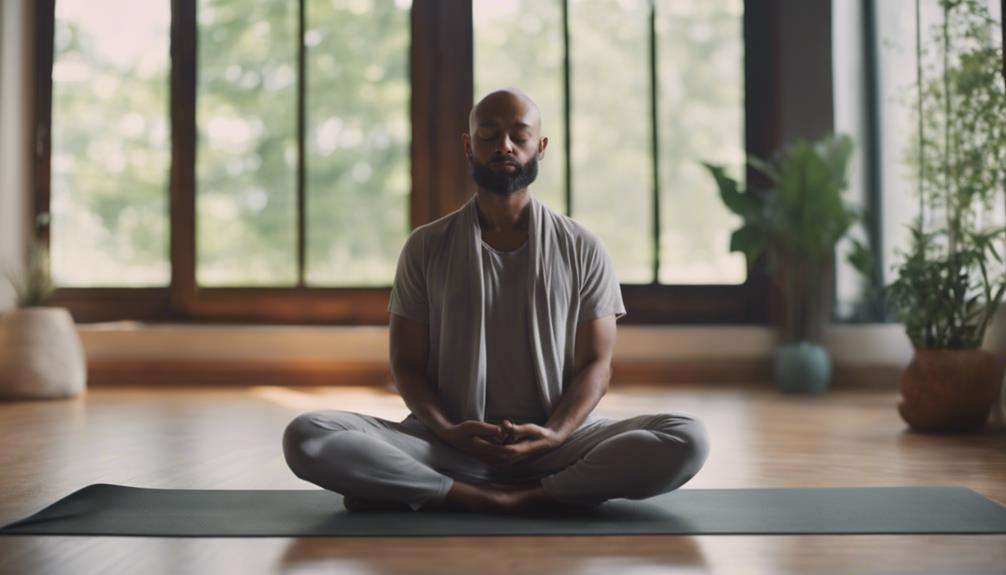
To enhance your flexibility with meditation, focus on your breath and stretch with awareness. By incorporating mindful breathing techniques into your practice, you can reduce muscle tension and promote relaxation in your body.
This mindful approach can help improve joint mobility, release tightness in muscles, and support better alignment for increased flexibility over time.
Breathing for Flexibility
Breathe deeply to enhance your flexibility and deepen your stretches. Incorporating controlled breathing techniques can significantly improve your stretching routine. Here's how mindful breathing can help you achieve greater flexibility:
- Oxygenating muscles through deep breathing reduces tension, allowing for deeper stretches.
- Combining breath work with stretching exercises improves range of motion and promotes muscle relaxation.
- Mindful breathing during stretching sessions enhances the mind-body connection, focusing your mind for better results.
Stretching With Awareness
Enhance your flexibility and deepen your mind-body connection by incorporating meditation into your stretching routine. Mindful stretching involves focusing on body sensations, breath, and movements. By paying attention to these elements, you can release tension, improve your range of motion, and reduce the risk of injuries.
Integrating meditation into your stretches not only enhances your flexibility but also strengthens the mind-body connection. This practice promotes relaxation, increases body awareness, reduces stress, and contributes to overall well-being. Consistent engagement in mindful stretching can lead to a profound understanding of your body's capabilities and limitations.
Embrace this holistic approach to stretching to experience the benefits of enhanced flexibility and a calmer mind.
Frequently Asked Questions
How Does Mindfulness Help You Relax?
Mindfulness helps you relax by reducing stress and anxiety through techniques like deep breathing and body awareness. It enhances mental clarity, connects mind and body, relaxes muscles, regulates emotions, and manages stress, triggering a relaxation response.
Does Mindfulness Improve Flexibility?
Mindfulness enhances flexibility benefits by deepening the mind-body connection, refining stretching techniques, and promoting mindful movement. It increases physical awareness, reduces stress, improves posture, and fosters a relaxation response through mindful breathing and stretching practices.
Is Mindfulness a Relaxation Technique?
Yes, mindfulness is more than a relaxation technique. It enhances awareness, acceptance, and calmness. Mindfulness helps you observe thoughts without reacting impulsively, leading to flexibility in handling stress. Embrace mindful practices for relaxation and mental resilience.
What Is a Key Difference Between Relaxation Training and Mindfulness Exercises Mindfulness Involves?
A key difference between relaxation training and mindfulness exercises is that mindfulness involves fostering mental clarity, present-moment awareness, emotional regulation, and self-compassion, while relaxation training primarily targets stress reduction, muscle tension, and the body's relaxation response.
Conclusion
As you continue your mindful practice, you may find yourself becoming more adaptable and open to new possibilities. Embrace the gentle flow of change and let go of rigidity.
Through relaxation and flexibility, you're cultivating a deeper sense of peace and harmony within yourself. Remember, the journey towards mindfulness is a journey towards self-discovery and growth.
Keep breathing, keep moving, and keep expanding your capacity for flexibility in both body and mind.
